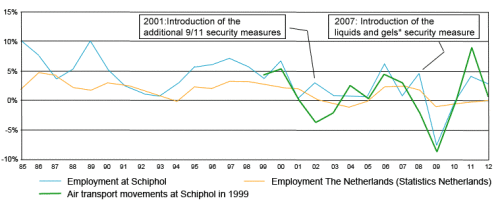While events around the world frequently cause a sudden dip in demand and income in aviation, initially there is usually a reverse phenomenon: an increase in costs and employment. This is clearly illustrated by the 9/11 attacks in the United States in 2001 and their aftermath, especially the Iraq war in 2002, as shown in Figure 7.

The graph shows how the 2001 dip in demand due to the 9/11 attacks was accompanied by a sudden surge in employment as a result of the labour-intensive security measures. This situation recurred in 2007 when the liquids and gels security measures were introduced following a series of foiled attacks at London Heathrow in August 2006.
The fact that the number of employees showed marginal growth (6.7%) compared with the number of air transport movements (5.7%) in the 2002-2012 period is largely attributable to the introduction of additional, extensive and labour-intensive security measures, as illustrated in the graph. In this case, an additional 3,000 jobs were created in total by security firms and law-enforcing authorities.